
by World Moms Blog | May 7, 2015 | 2015, Awareness, Being Thankful, Birthing, Casting a Wider Net, Clean Birth Kits, Education, Global Citizenship, Health, Helping, Human Rights, International, Life, Life Lesson, Loss of Child, Maternal Health, Motherhood, Newborn Health, ONE, Pregnancy, Priorities, Responsibility, Tragedy, Transportation, Womanhood, Women's Rights, Working Mother, World Mom Feature, World Motherhood
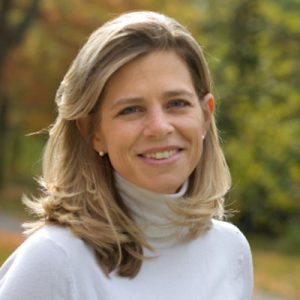 Every mother has the right to access the care they need during pregnancy and childbirth – care that can identify, prevent, and manage complications should they arise. But failure to meet these needs results in the loss of 800 mothers every day, even though up to 98% of these deaths are preventable.
Every mother has the right to access the care they need during pregnancy and childbirth – care that can identify, prevent, and manage complications should they arise. But failure to meet these needs results in the loss of 800 mothers every day, even though up to 98% of these deaths are preventable.
Every Mother Counts is working to provide solutions that can make pregnancy and childbirth safer. We know that with the right care at the right time, it IS possible that every mother could have the chance to survive and thrive.
Recently, World Moms Blog sat down with Executive Director of Every Mother Counts, Erin Thornton, to talk about how she got involved with the organization and what drives her to work so hard for maternal health.
World Moms Blog: Erin, you’re the mother of three young girls and you live in the metro-Boston area yet you are the executive director of Every Mother Counts, a New York-based non-profit working in five locations around the world. How did you get involved?
Erin Thornton: My involvement with Every Mother Counts grew out of a 10-day trip to Africa with my former organization, ONE. We had invited Christy Turlington Burns along and she and I got chatting about maternal health. Maternal health was not an issue ONE focused on and I was really drawn to what Christy was telling me about.
WMB: What about maternal health drew you in?
ET: Well, Christy had just completed the film, “No Woman, No Cry” a documentary about maternal health challenges that impact the lives of millions of girls and women around the world. During our trip through five African countries, Christy and I spent a lot of time comparing notes on what was needed to move the maternal health agenda forward. Through all my time at ONE, I realized how interlinked so many poverty challenges are to maternal health—that if moms are kept alive, we can better keep kids alive, better give them an education and clean water, etc. Yet still no one was really talking about it.
WMB: What prompted you to leave behind a long career with ONE and join Christy in her pursuit of spreading maternal health awareness as she built this new non-profit?
ET: I had been with ONE since 2002, when I became the first hire in the US for ONE’s predecessor organization, DATA. By 2010, ONE had grown to 120 people in four different global offices. I had two young girls and I was starting to think about making a change. The more Christy and I talked about the need for an “awareness campaign” for maternal health, the more I realized I wanted to be a part of it too, so six-months later, I formally signed on to help her build the organization.
WMB: In just a few days (May 10), we celebrate Mother’s Day here in the US, can you share with World Moms something about what makes you a passionate believer in Every Mother Counts?
ET: Physiologically, every woman goes through pregnancy the same way and faces the same chances of developing a complication. The difference in how they fare mainly comes down to whether they have access to good health care- or not. Helping more moms enjoy a safe pregnancy and delivery may sound like an overwhelming challenge but we really CAN make a difference. EMC has identified three target areas to focus our support on: 1. transport, 2. education and training for healthcare providers, and 3. supplies for clinics–including birth kits, solar suitcases and lighting. And we’re seeing that these seemingly simple things are making a big difference.
This Mother’s Day, Every Mother Counts is celebrating #WhatIsPossible for every mother.
Every mother has the right to access the care they need during pregnancy and childbirth – care that can identify, prevent, and manage complications should they arise. But failure to meet these needs results in the loss of 800 mothers every day, even though up to 98% of these deaths are preventable.
Every Mother Counts is working to provide solutions that can make pregnancy and childbirth safer. We know that with the right care at the right time, it IS possible that every mother could have the chance to survive and thrive.
So this Mother’s Day, as we look at the future of maternal health, we ask ourselves #WhatIsPossible? And the answer is, a lot.
With your help, Every Mother Counts has already impacted thousands of lives by improving access to critical maternal health care for vulnerable mothers.
During the month of May, we invite you to spread the good news about by sharing this .
This is an original interview with Erin Thornton posted by World Moms Blog Managing Editor, Kyla P’an.
The image used in this post is from the Every Mother Counts website and is used here with permission.
World Moms Blog is an award winning website which writes from over 30 countries on the topics of motherhood, culture, human rights and social good. Over 70 international contributors share their stories from around the globe, bonded by the common thread of motherhood and wanting a better world for their children.
World Moms Blog was listed by Forbes Woman as one of the "Best 100 Websites for Women 2012 & 2013" and also called a "must read" by the NY Times Motherlode in 2013. Our Senior Editor in India, Purnima Ramakrishnan, was awarded the BlogHer International Activist Award in 2013.
More Posts
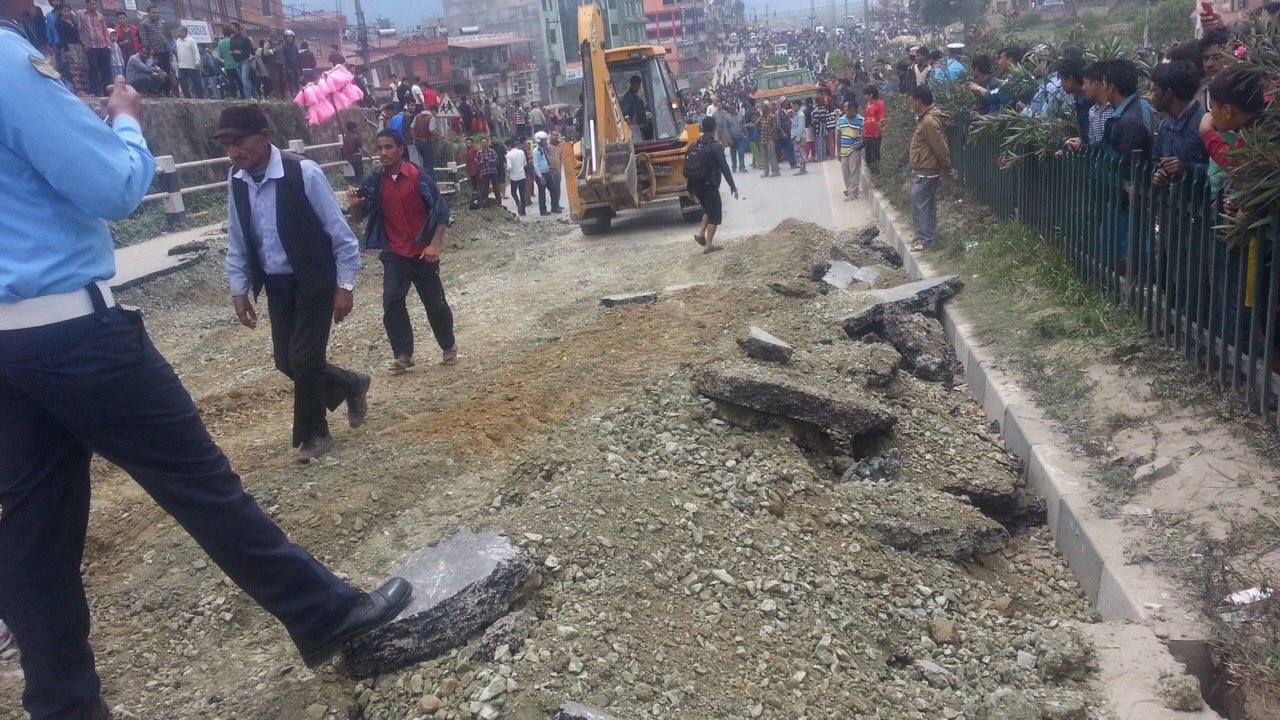
by Purnima Ramakrishnan | May 5, 2015 | 2015, Global Citizenship, Helping, Humanitarian, India, International, Natural Disaster, Nepal, United Nations, World Moms Blog, World Voice
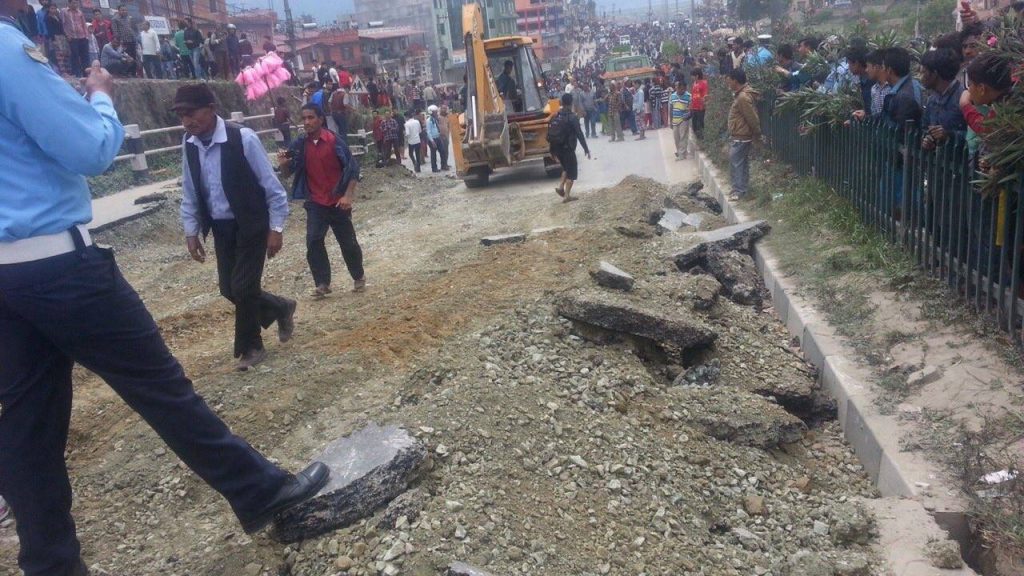
As an Indian, writing about the #NepalEarthquake today, I have to share a few interesting facts about the Indo-Nepal relationship. An Indian National does not need a VISA to travel to Nepal, and an Indian National does not need even a passport to enter Nepal.
An Indian National only needs some sort of ID card on him to show that he is in an Indian National. And then he is free to come and go.
That is the level of friendship, comradeship, and mutual trust and confidence the countries have on each other. It is just like traveling to another state within India.
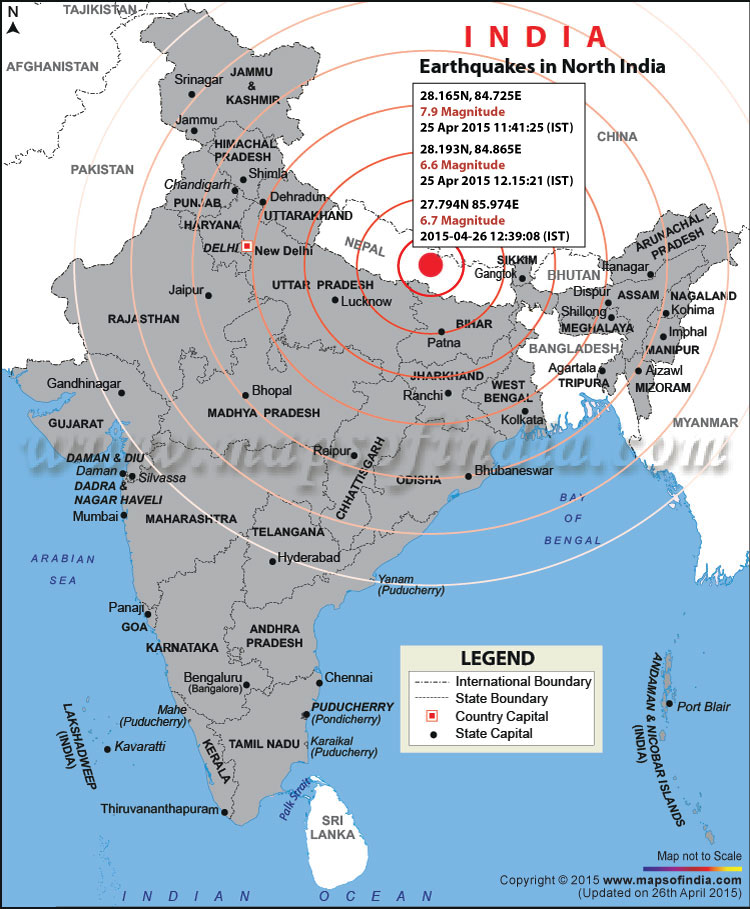
location-map-of-earthquake-on-25-april-2015-in-entire-india
It was a great shock to hear about the earthquake on Saturday April 25th. On this date, Nepal was hit by earthquake of a 7.8 magnitude that has killed over 7000 people. The death toll is unfortunately estimated to increase up to 10,000 as rescue efforts span out to remote regions of the epicentre. Nepal has experienced over 50+ aftershocks of 4.5 magnitudes or higher after the initial earthquake.
The injured are in need of desperate medical attention. Countless have lost their homes and are on streets in need of food, water, and medical supplies.
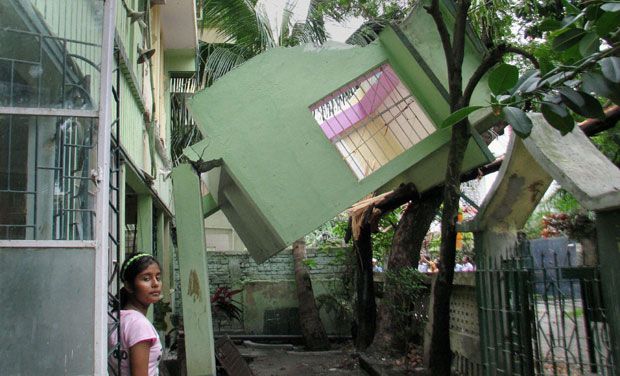
Buildings collapsed in Siliguri, North India
I was traveling in North India when I learned about the #NepalEarthquake. Some parts of Delhi, Lucknow, Bihar (all in India) felt the tremors and aftershocks. At least 60 people were killed in North India and more than 100 injured during this period. I frantically checked for all my friends in North India and Nepal. I even got a call from my friend and fellow World Mom, The Human Rights Warrior, Jennifer Prestholdt to help contact the school in Nepal that her organization works closely with. Major telecom provider #Airtel had made all calls free from India to Nepal. You can read her story about when she finally got the news she was hoping for, and when she read the text message “All our SPCS family r safe,” from Anoop Poudel, headmaster at the Sankhu-Palubari Community School (SPCS) in Nepal.
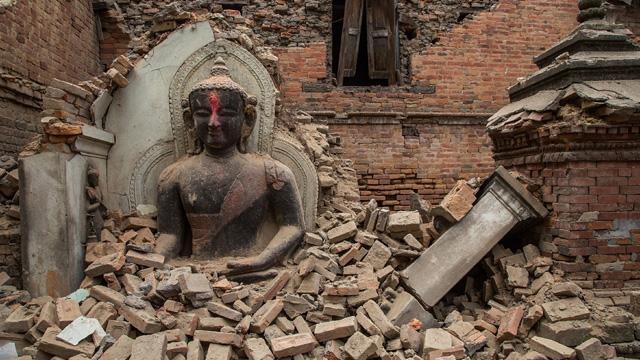
Aftermath and rubble
Indian government’s Operation Maitri (meaning friendship) aptly called so, has started helping within 15 minutes of the earthquake.
Organizations like Save the Children, Red Cross, UNICEF, WFP and Care are on the ground with supplies and volunteers. These organizations have teams on the ground and are the most capable in immediate rescue and relief work.
1. Save the Children
Save the Children is an international charity that has been in Nepal since 1976. In fact, when the earthquake hit, there were nearly 500 of their aid workers, mostly Nepalese, on the ground who were already doing work in the area. This was a great help when there were difficulties with the airport at first, according to Carolyn Miles, President and CEO of Save the Children. Also, 10% of funds are going to preparations for future disasters. You can donate to their Nepal Earthquake Children’s Relief Fund.
2. Red Cross
The Red Cross has committed an initial $300,000 of aid as well as 19,000 non-food relief kits. You can donate to the Red Cross Nepal Earthquake Relief Fund.
3. Global Giving
Online fund-raising platform Global Giving is running a project to raise $1,000,000 for disaster relief in Nepal and has raised over $570,000 so far.
To make a donation, visit Global Giving here. If you have a U.S. cell phone, you can text GIVE NEPAL to 80088 to make a $10 donation.
4. Friends Service Council Nepal
FSCN is a Nepalese NGO with over 20 years of experience in supporting disaster relief efforts for disasters in Nepal. If you want to give directly to a local charity, get in contact and a volunteer will explain how best to transfer money to them.
5. Oxfam
Oxfam, which works in more than 90 countries, has already dispatched technical experts from the U.K. to Nepal.
To make your donation to Oxfam’s relief effort, go here.
6. Goonj
Goonj is an Indian relief agency with 11 offices and more than 300 employees. Currently, Goonj is readying two trucks of relief material to transfer to Nepal, with more urgent supplies going by air. For more information about how to donate, visit their website.
Additionally, you could also consider donating at the following links/websites.
Sarvodaya USA: Which is a Madison, WI based non-profit organization. They have done some good work in Nepal and Sri Lanka. They now have volunteers helping in relief work.
UNICEF
World Food Program
Care
Global Outreach Doctors
There are local organizations that are on ground taking care of the survivors and injured. If you wish to make contributions to these organizations, please visit their website below.
Nepal ko Yuwa
And you could contribute too, in other ways, by sending your prayers, thoughts of love, unity and world brotherhood to all of them affected there, the survivors and the long passed souls. Let us pray for some peace.
This is an original post from our World Mom and Senior Editor in India, Purnima Ramakrishnan.
Her contributions to World Moms Blog can be found here. She also rambles at The Alchemist’s Blog.
Photo credit to Krish Dulal Creative Commons, Deccan Chronicle, Maps of India, European pressphoto Agency.
Article has been written with inputs from author’s friend having close ties with relatives on field in Nepal, Time.com and local Indian TV News channels.

by Jennifer Burden | May 4, 2015 | 2015, Health, Motherhood, Save The Children, World Interviews, World Moms Blog, World Voice
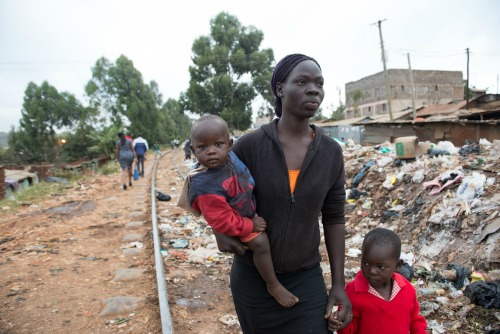
Family living in Kibera, the largest slum in Nairobi, Kenya.
Last week, World Moms Blog conducted an exclusive interview with Save the Children’s President and CEO, Carolyn Miles and Vice President of Global Health, Robert Clay at the United Nations headquarters in New York City. Our conversation was around the State of the World’s Mothers Report for 2015, released today! Carolyn had recently returned from Haiti, and was enthusiastic to speak about this year’s findings…
Jennifer Burden: The State of the World’s Mothers Report now covers 179 countries, how many years has it existed?
Carolyn Miles: This is the 16th report, and I have been with Save the Children for 17 years. It came about as a connection between the well-being of mothers and children around the world. The report measures the well-being based on 5 indicators: economic, education, maternal health, child survival and the representation of women in government.
JB: The theme of the report in 2015 seems to focus on urban areas. Save the Children is pulling apart statistical averages in cities. Why?
CM: It is driven by getting to the hardest to reach children. Seventeen thousand children die per day. That has halved from 33,000 since 1990. We are answering the question of, “Where are the hardest to reach children?” And the cities are where the world’s population is going. In 2007 there were 51% of people on the planet living in cities. Today that number is 54%, and the city population is rapidly increasing. Cities are where the children, mothers and parents are living.
Families move to the cities looking for a better life, but in the poorest areas, the urban slums, children there are 2 times as likely to die than the richest kids in the same city.
If you look at the averages, the averages in cities are generally better than in rural areas. But, if you break it down, the poorest kids in cities are 2 times as likely to die as the richest kids in cities. And, those kids are also more likely to die than children in the rural areas.
JB: The urban data — when we think of child survival rates and socioeconomic disparities, most may think of cities such as Kampala, Delhi or Rio, but the report hits home, here, in the U.S. Can you tell us about Washington, D.C.?
CM: Yes, we looked at 25 capital cities in high income countries and the infant mortalities, including the deaths of infants under the age of one. Washington, D.C. was at the bottom. When we compared the wealthiest district and the one with the most poverty, children in the district with the most poverty were 10 times more likely to die than children from the wealthiest district.
Inequality is an important issue in the United States.
Urbanization in 2030 is expected to account for 65% of the population and to further increase in 2050.
Also, a key point is that the data is weak. We are looking at the DHS infant mortality rates, and the world needs to do a better job in accounting for this data.
JB: What was the biggest surprise this year?
CM: It was no surprise that the Scandanavians are always at the top. If we really want mothers and children to have a better life, we should support them.
To give a really specific answer, inequality is killing kids.
I just returned from Haiti 2 days ago. Haiti is in the bottom 10 and hasn’t been there in a long time. Number 1, the country has a very low education rate. Fifty percent of children do not get through primary school. Number 2, the decreased strength in the government slowed progress. I met with a bunch of moms and babies who are getting very basic healthcare, but more has to be done.
(Haiti is tied at number 169 with Sierra Leone in the 2015 Mothers Index Rankings and was just shy of the bottom 10 at number 168 last year in the 2014 Mothers Index Rankings.)
JB: What was the biggest success story?
CM: Panama made a lot of progress this year and has moved up in the rankings. This was driven by education and improvements in the representation of women in their government.
(Panama moved up to number 78 in the 2015 Mothers Index Rankings. That is a jump of 31 spots, from a ranking of number 109 in the 2014 Mothers Index Rankings.)
JB: As I read in the report, Carolyn, you have an interesting “World Mom Moment” that led you to leave the corporate world and work for Save the Children. (According to the State of the World’s Mothers Report 2015, Carolyn was in Manila holding her 6 month old son 20 years ago, and she felt that it wasn’t right that children she saw in poverty would have a very different chance at life than her son. It was that experience that led her to leave the corporate world and join Save the Children.) So, on World Moms Blog, we always ask, “What is your wish for world mothers?”
CM: Yes, I did, in Manila while holding my son when he was a baby! My wish is mostly that every mother has the basics: basic healthcare, that their children can go to school, and in conflict countries that moms and children are protected.
JB: What is the one action you would like us to take and encourage our World Moms Blog community to take to help mothers and children worldwide?
CM: Just one? (laughter) Please go to the Save the Children Web Site!
1) Donate to the programs — there are many choices!
2) Save the Children has a policy ask. To press the US government, a world leader in child and maternal health, to pass the Coons, Graham and Cardin Bill to support global maternal and child health programs. We must keep pushing.
3) In the new UN Goals there is a big focus in inequality. We think that is REALLY important that we ask that these goals are supported in order to reach the most deprived kid. These are the goals that every country will sign off on.
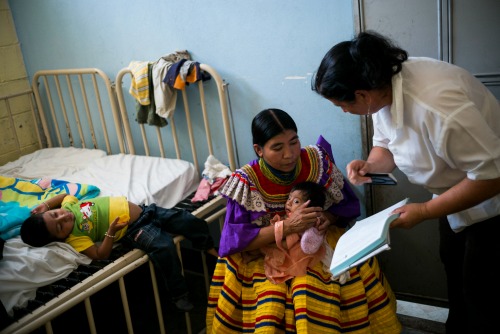
Photo credit to Save the Children.
JB: Next, we have fielded some questions from our World Moms Blog contributors. First, Cindy Levin, the Anti-Poverty Mom in Missouri, USA asks, “What is the biggest area of opportunity to save kids lives this year…vaccines? nutrition?”
CM: It is hard to pick one. This year it’s important to get the new goals right, and we’re pushing for children to be central to them. In 1980 that is how things were done — one goal would be focused on. But when you only have a vertical lens, you’re not taking advantage of the integration of services.
Now, the focus is on smart integration to meet the demands of the children.
For example, in Nepal, the focus is on nutrition, as well as, water and sanitation. If a child is getting proper nutrition, but is drinking dirty water, then they are going to get sick and the nutrition alone won’t help. They have to work together.
JB: Next, our contributor, Kristyn Zalota of Cleanbirth.org in Connecticut, USA asks, “The largest obstacle moms in Southern Laos have to reaching a clinic is distance and lack of transportation. How common an obstacle is this for women worldwide?”
CM: Very common. Transport is a big barrier for women worldwide. Some of the solutions we are using are to construct mother homes next to clinics to decrease the distance, and her family can join her, like a birthing hut system. Another way to get the pregnant mother to the clinic is by ambulance. We line up the ambulances ahead of time in anticipation of the birth. For example, in Uganda, bicycle ambulances are used, and they have a sled in the back for the mother.
JB: Lastly, Maryanne W. Waweru of Mummy Tales in Kenya asks, “In societies that are very patriarchal and in communities that still uphold retrogressive cultures (this is so in many African cultures), where a woman’s reproductive health decisions are dictated by men (fathers, husbands, brothers, etc.), how is Save the Children working with men in this regard? Any examples?”
CM: This is a really important question. I’ll give you an example in Uganda, where there are lots of family planning clinics available that are supported by the government. But yet, we found that not all mothers were using them because they had not gotten permission from their husbands. So, sometimes access is not the problem.
Save the Children is encouraging and having “family discussions”, a way of bringing men into the discussions. We give them stats, economics, etc. that leads to the the better health of children and family spacing.
Robert Clay: Save the Children also works with adolescents on this topic. We are bringing boys and girls into the discussions before they are having children, and we talk to them about their roles and responsibilities.
Another example of how I have seen this work is through my prior work with USAID. We had soccer games for the boys with an additional afternoon discussion around sexuality. At the beginning, most of the boys only wanted to play soccer and made it clear that was what they preferred to do. Many were hearing for the first time factual information about sex, their roles as men and how to establish responsibility early on. Then, as they attended more discussions, the boys spoke of their preference to spend more time in the discussions than playing soccer!
Additionally, there is a women in government piece to this question. Societies with more women in decision making roles pass policies that are friendly to women and children. And when it comes to economics, when women have money they invest in their children.
Thank you to both Caroline Miles and Robert Clay for this exclusive interview. After the interview, there was a press conference at UN Headquarters including information on the 2015 State of the World Mothers Report. Look out for a follow up post on WorldMomsBlog.com about the press conference.
This is an original post to World Moms Blog by founder, Jennifer Burden of New Jersey, USA.
Updated May 5th, 2015. Carolyn had her “World Mom Moment” in Manila, not Hong Kong, as previously stated.
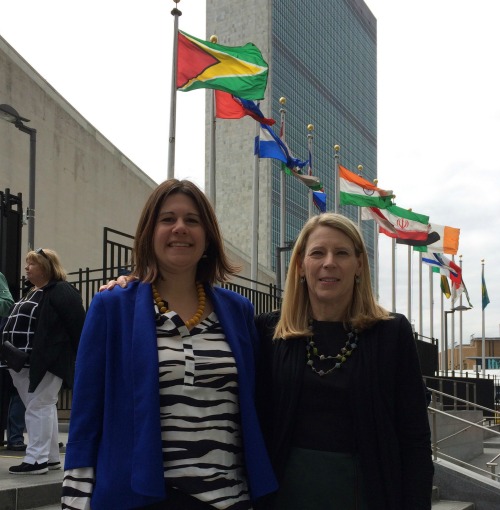
Jennifer Burden, Founder of World Moms Blog with Carolyn Miles, President and CEO of Save the Children at the United Nations, April 30, 2015.

Jennifer Burden is the Founder and CEO of World Moms Network, an award winning website on global motherhood, culture, human rights and social good. World Moms Network writes from over 30 countries, has over 70 contributors and was listed by Forbes as one of the “Best 100 Websites for Women”, named a “must read” by The New York Times, and was recommended by The Times of India.
She was also invited to Uganda to view UNICEF’s family health programs with Shot@Life and was previously named a “Global Influencer Fellow” and “Social Media Fellow” by the UN Foundation. Jennifer was invited to the White House twice, including as a nominated "Changemaker" for the State of the World Women Summit. She also participated in the One Campaign’s first AYA Summit on the topic of women and girl empowerment and organized and spoke on an international panel at the World Bank in Washington, DC on the importance of a universal education for all girls. Her writing has been featured by Baby Center, Huffington Post, ONE.org, the UN Foundation’s Shot@Life, and The Gates Foundation’s “Impatient Optimists.” She is currently a candidate in Columbia University's School of International and Public Affairs in the Executive Masters of Public Affairs program, where she hopes to further her study of global policies affecting women and girls.
Jennifer can be found on Twitter @JenniferBurden.
More Posts - Website
Follow Me:


by Kristyn Zalota | Apr 21, 2015 | 2015, Awareness, Babies, Birthing, Clean Birth Kits, Humanitarian, Inspirational, Laos, Motherhood, Newborn Health, Philanthropy, Social Good, World Moms Blog, World Voice
The Truth About Fundraising.
When I talk about the fundraising work that I do for the organization I started, CleanBirth.org, I often hear in response, “I could never ask people for money.”
I’ll be honest, I don’t have a choice. When I began providing moms with life-saving birth supplies, in partnership with a local NGO in Laos, I used my own funds. Happily, the $5 kits proved effective and more moms wanted the sterile, convenient supplies that prevent deadly infections in moms and babies. How could I say no?
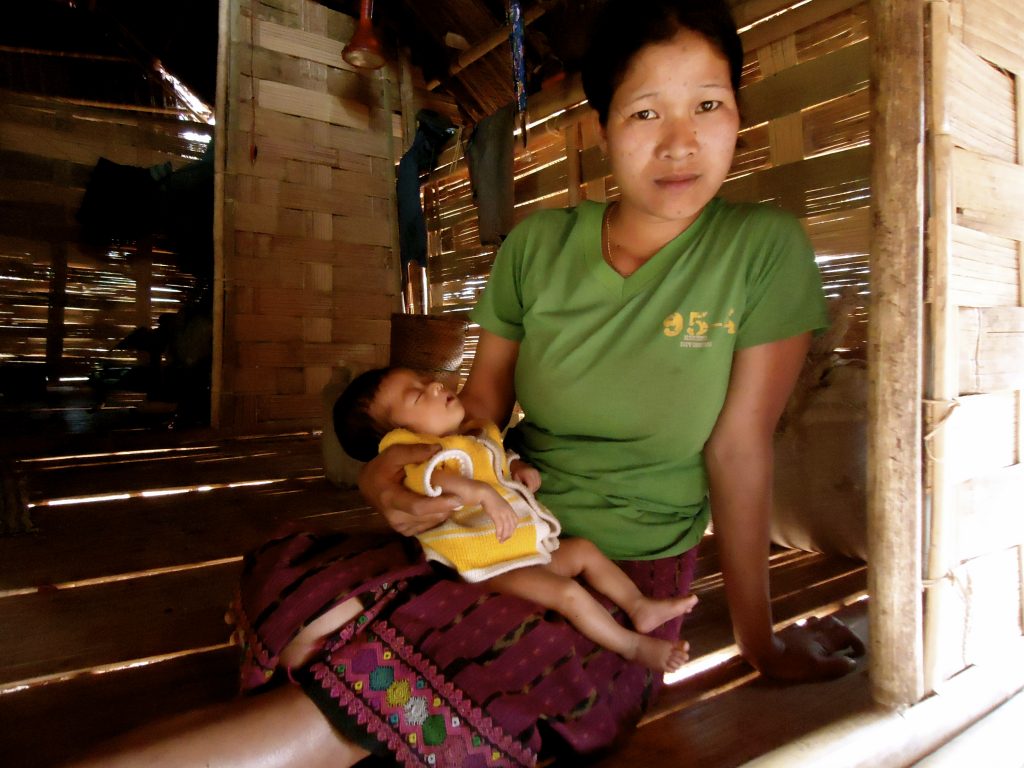
So I promised to fund as many kits as were needed.
Since we began in November 2012 we have provided 4,000 birth kits to moms and training for 180 nurses and staff.
Knowing that my own funds couldn’t sustain the project, I told my story to others. I wasn’t great at promoting the project at first but many friends and family supported me anyways. The tagline: $5 Saves 2 Lives in Laos proved irresistible.
Now 3 years on, the project has grown beyond my own social network. Thanks to bloggers at World Moms Blogs and others, we have extended our reach worldwide. I am constantly touched by the simple notes of support that accompany donations from complete strangers:
Thank you for doing what you do for mothers and babies!
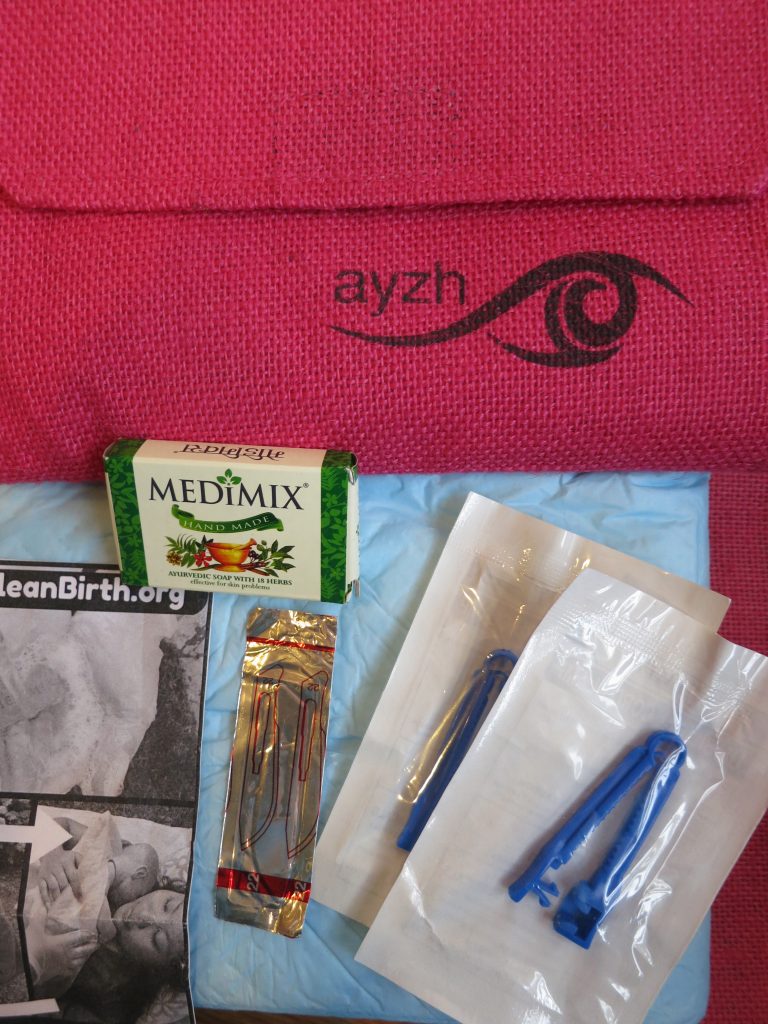
Another great aspect of fundraising is working with others who want to share their special gifts to make birth safer. One example is a fun collaboration happening now for Mother’s Day. World Moms Blogger and photographer Ewa Kuc of Ewa Samples Photography in the Bay Area has developed awesome Mother’s Day photo session packages. A full 40% of the profits go to CleanBirth.org!
In my almost 3 years doing this, I have come to appreciate that fundraising is a give and take proposition.
I’m not just taking money but giving something to donors: a feeling of making a positive impact in the world; the piece of mind that comes from donating to a transparent, registered organization; or a tangible gift to give a loved one.
One such gift, our $10 Mother’s Day cards, honor mom or grandma & provide 2 moms in Laos with Clean Birth Kits.
So the truth about fundraising is that I do ask for money. (Please click here to buy our Mother’s Day cards!! J) But I also get to connect with many generous people who are committed to making their world a better place. We each give, and we each take. Not so scary after all.
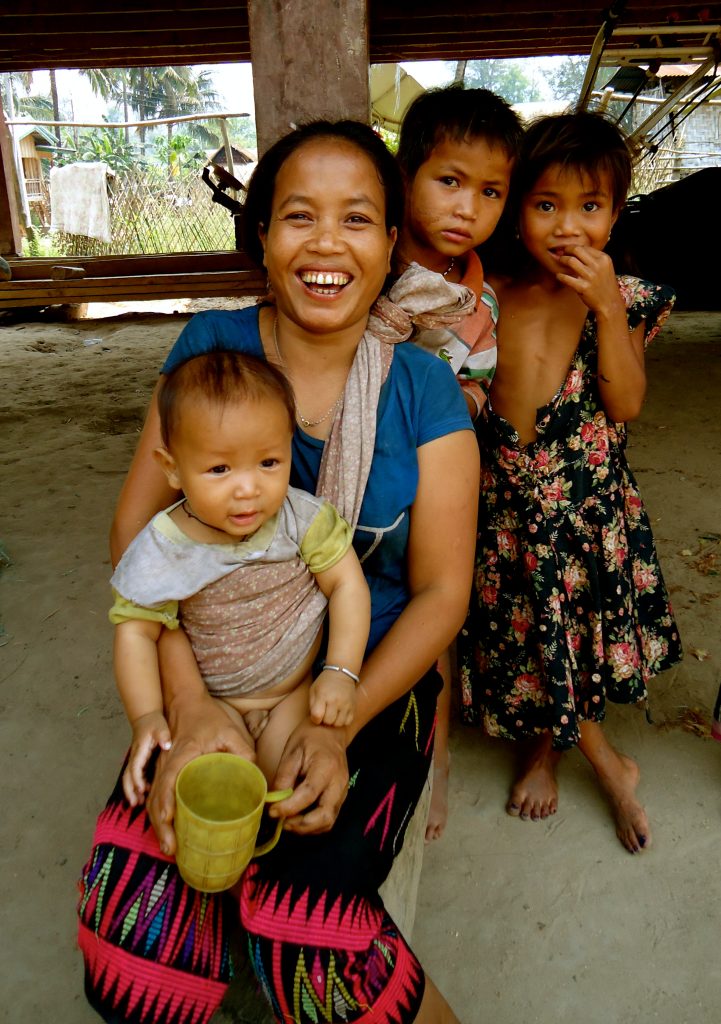
What benefits do you receive from donating or volunteering with a non-profit?
This is an original post written for World Moms Blog by Kristyn Zalota, the founder of Clean birth.org
Photo credits Kristyn Zalota.
Kristyn brings her years of experience as an entrepreneur and serial volunteer to CleanBirth.org. She holds a MA, has run small businesses in Russia and the US, and has volunteered in Nicaragua, Costa Rica, Thailand, Cambodia, Laos and Uganda on projects related to women’s empowerment.
After having children, Kristyn became an advocate for mothers in the US, as a doula and Lamaze educator, and abroad, as the Founder of CleanBirth.org. She is honored to provide nurses in Laos with the supplies, funding and training they need to lower maternal and infant mortality rates in their villages.
More Posts

by Jennifer Burden | Apr 16, 2015 | 2015, World Bank, World Moms Blog, World Voice
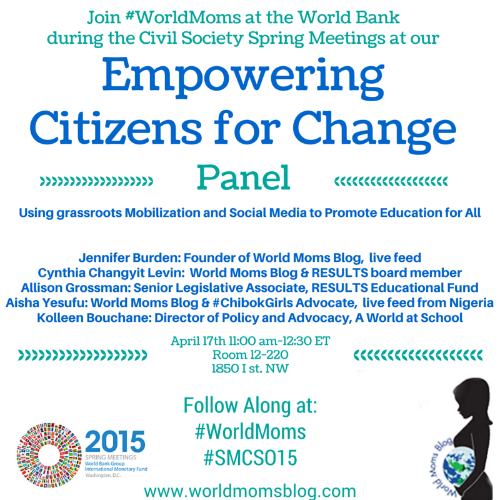
This week, World Moms Blog was invited to take part in the World Bank/IMF Civil Society Meetings in Washington, DC. I had the opportunity to be there Tuesday and Wednesday, and World Mom, Cynthia Levin, took over for Thursday and Friday.
The World Bank has a long history of lending since Breton Woods in 1944 when it was established after World War II. But, over the years it has also lended to projects that have had a negative impact on the local people in developing nations. And after years of protesting the World Bank, anthropologist and Partners in Health cofounder, Dr. Jim Kim, has been at the helm of the bank as President for the past 3 years.
The protests have now been brought off the streets and members of the public have been invited inside around the World Bank and IMF fall and spring meetings to represent the people in the countries where the bank lends. So, all is perfect now, right?
Development isn’t easy. There are still challenges when it comes to lending and looking out for the societies receiving the loans. The topics are intricate in the bank’s mission to end poverty and are reflected in over 50 different panels that are being presented at the meetings.
Here are my top 10 takeaways about the first two days of the Civil Society Meetings…
1) Not everyone here is from DC. The Civil Society Meetings attract and bring in a host of civil society members across continents to come and join in the conversations around poverty. In fact, a large portion of the meeting panels were pitched by civil society members. They are helping carve out the bank’s future practices (safeguards), providing new points of view by representing the people from their home countries and networking with their counterparts abroad to trade best practices and solutions.
2) Dr. Kim, World Bank President, says that the world can end extreme poverty by 2030. In 1993 41% of the world’s human population was living in extreme poverty (under $1.25 per day). With the help of the UN’s Millennium Development Goals (Do you remember our #Moms4MDGs campaign last year?) that percentage has been reduced to 14% in 2014 (data is still coming in to confirm this projected number). Statistics are according to the World Bank.
3) Some of the people on the planet who may be most affected by climate change know nothing about it. In the Pathway to Paris working panel on climate change, civil society members from Hoduras and Bolivia explained that when your focus is that you need to eat, climate change is not on the minds of people, but how to get food is. And they stated that when people are aware of the climate change problem, they expect that it is a problem to be dealt with by the developed world.
4) The consequences of radicalization and violent extremism in fragile societies is a popular emerging topic of interest among civil society members. There was a packed crowd (think Tokyo subway car) in the panel on the consequences of radicalization and violent extremism, and I didn’t get in! I really wanted to listen in on the conversation, but noted it was a high priority on civil society’s agenda as something that needed to be changed.
5) To reach the goal to end extreme poverty faster, the World Bank sees the importance in partnering with faith-based organizations. There were several panels on Wednesday, including a flagship event, that included members of the world’s largest religions discussing their motivations to help the poor from their faith. The key takeaway was that although the World Bank is a secular organization, there are benefits to ending poverty faster by working together with faith based organizations.
6) Human rights has not been written in as part of the World Bank’s safeguards and civil society is protesting. A man from the LBGT community, chased out of his home country of Uganda, asked the World Bank executive directors why they continue to lend to countries who do not value the rights of their people. Also, during a round table discussion with executive directors from the World Bank and the IMF, a woman from South Africa asked for a moment of silence for children who had died from the impact of a World Bank development project (I do not know the details of the project she was referring to.). Afterwards, a group of civil society members stood in unity with her wearing or holding yellow shirts demanding human rights be written into the bank’s safeguards. Civil Society members are standing up for their rights and joining the conversation to try to change bank policy.
7) The smallest member of the World Bank Group is MIGA. MIGA stands for Multilateral Investment Guarantee Agency and has only about 33 employees and lends in the the most fragile states. For example, they were lending in Afghanistan when bullets were flying!
8) The official twitter feed for the IMF/World Bank Civil Society Meetings is “SMCSO15”. This is according to the postings in the meeting rooms at the World Bank. Twitter also self-populates with another hashtag being used, “SMCSO2015.” The twitter feed picks up on the flagship panels that are broadcast live to the public, which makes the online conversation awesome around ending poverty. You can check out our post from earlier this week on those flagship panels that have live feeds.
9) The open meeting policy at the World Bank allows the bank to hear and anticipate the effects of their lending in ways they haven’t in the past. Could you imagine if every business had this type of open meeting policy where civil society could pitch panels on the way in which it lends to better society? Although born out of unfair lending practices and people protesting the streets of the past, this model is ground-breaking. And the world needs ground-breaking when it comes to getting people out of extreme poverty and achieving the sustainable development goals of 2030.
10) World Moms Blog’s panel on grassroots advocacy and social media in support of universal education is a go! On Friday, April 17th at 11am ET, World Moms Blog’s Cynthia Levin (USA & also of RESULTS), Aisha Yesefu (Nigeria) and myself, Jennifer Burden (USA), will team up with Allison Grossman of RESULTS and Kolleen Bouchane of A World at School to discuss ways in which civil society members can ignite change in getting more children into the classroom. Today, over 57 million children of primary school age on the planet are not being educated. The topic is vital and also very timely with the passing of the 1 year anniversary this week of the capturing of the Chibok Girls of Nigeria. We hope you will join us on Twitter under the hashtag #WorldMoms and #SMCSO15.
We agree that civil society should be a part of the conversation to effect change. You can join the World Bank Live Feed this week, too.
This is an original post to World Moms Blog by founder, Jennifer Burden in the USA. The World Bank has provided funding for Jennifer and Cindy to attend the meetings this week to help engage more members of civil society in the global discussions to end poverty, but has not directed our voice.

Jennifer Burden is the Founder and CEO of World Moms Network, an award winning website on global motherhood, culture, human rights and social good. World Moms Network writes from over 30 countries, has over 70 contributors and was listed by Forbes as one of the “Best 100 Websites for Women”, named a “must read” by The New York Times, and was recommended by The Times of India.
She was also invited to Uganda to view UNICEF’s family health programs with Shot@Life and was previously named a “Global Influencer Fellow” and “Social Media Fellow” by the UN Foundation. Jennifer was invited to the White House twice, including as a nominated "Changemaker" for the State of the World Women Summit. She also participated in the One Campaign’s first AYA Summit on the topic of women and girl empowerment and organized and spoke on an international panel at the World Bank in Washington, DC on the importance of a universal education for all girls. Her writing has been featured by Baby Center, Huffington Post, ONE.org, the UN Foundation’s Shot@Life, and The Gates Foundation’s “Impatient Optimists.” She is currently a candidate in Columbia University's School of International and Public Affairs in the Executive Masters of Public Affairs program, where she hopes to further her study of global policies affecting women and girls.
Jennifer can be found on Twitter @JenniferBurden.
More Posts - Website
Follow Me:


by Aisha Yesufu | Apr 14, 2015 | 2015, Africa, Awareness, Education, Girl Child, Girls, Global Citizenship, Government, Grief, Human Rights, Humanitarian, International, News, Nigeria, World Moms Blog, World Voice
365DaysOn the Chibok Girls are never to be forgotten.
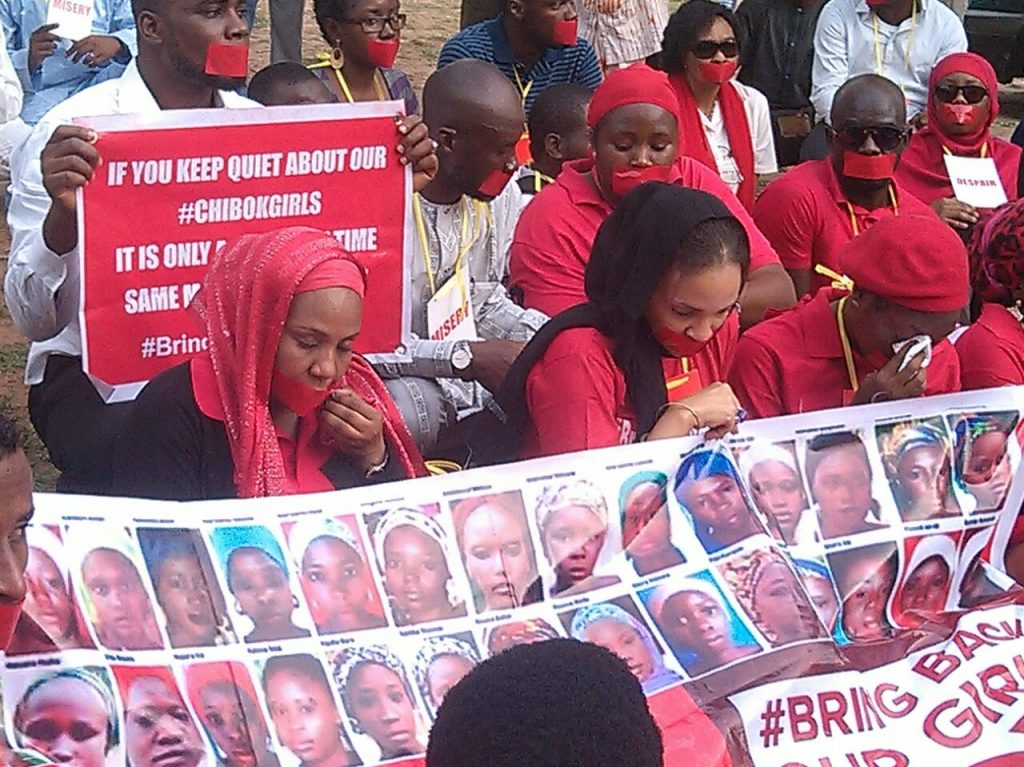
It is 365 days today that the Chibok Girls were abducted. Exactly one year ago on 14th April 2014 276 Chibok School Girls were abducted from their school. I just cannot believe the fact that we actually allowed it to get to one year without the rescue of our #chibokGirls. How could we allow innocent children be taken away by terrorist group and do nothing. The #ChibokGirls ought not to have been taken in the first place. They were supposed to be protected to enjoy their Childhood and their innocence. We failed to protect them and also failed in the next best thing which would have been their immediate rescue. How can we live with ourselves? How do we live with our consciences? How do we face ourselves in the mirror knowing fully well that we abandoned 219 #ChibokGirls and left them with the terrorists.
What is the crime of #ChibokGirls? Is it because she is Nigerian? Is it because she is poor? Or is it because she dared to be educated? #ChibokGirls against all odds dared to be educated and on April 14th 2014 they paid for daring. A group of armed terrorists entered their school and abducted 276 of them from their school in Chibok. 57 of them escaped on their own and there are still 219 of them still with the abductors for a year today, and not a single one has been rescued. The armed terrorists group known as Boko Haram, literarily meaning that western education is forbidden, have vowed to get schools closed down and seem to be succeeding. For some children in the North Eastern States of Nigeria education has become truly forbidden as schools in some parts have been closed for over a year.
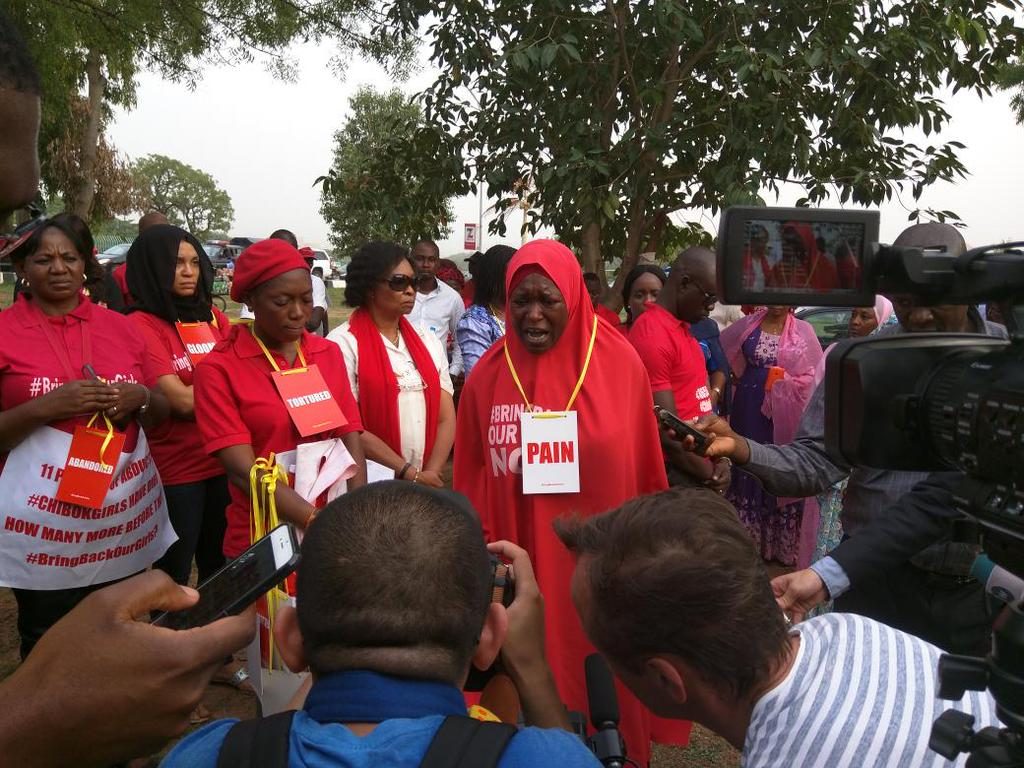
The #ChibokGirls were writing their Final year examination after which those who passed would be able to secure admission into University. A beacon of hope for their families. Schools had been closed down in neighbouring towns and a lot of parents sent their children to be able to complete their secondary school education in Chibok.
There had been series of attacks within some neighbouring villages and yet the #ChibokGirls went to school. Even those who were not boarders went to stay in school because there was electricity there and they wanted to have a place to read for their exams. Sheer determination to get an education which they knew would be their key to breaking the shackles of poverty. For the #ChibokGirl education meant everything. It was the path that could lead to an end to the vicious cycle of poverty. Like one of the #ChibokMothers said to us when we invited them to one of the Sit Outs we had, said her daughter had promised to go to school to get an education and wipe away her tears. The mother asked us; “If my daughter is in the hands of terrorist how she will wipe away my tears?
For most of these parents their children are everything, including a future source of livelihood. What makes the #ChibokGirls issue so saddening is that a lot of children, especially the Girl-Child from the region of Nigeria they come from, hardly ever go to school. They are the most educationally disadvantaged and it takes a lot to get them to school, especially the girls.
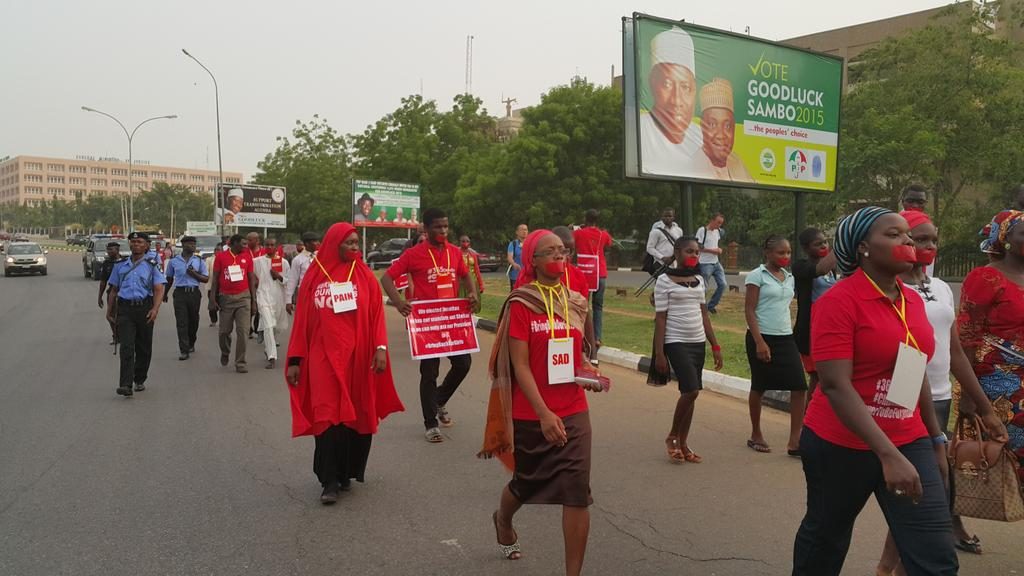
One of the #ChibokFathers put it this way: ‘The government fines us if we do not send our children to school. Now that our children have been abducted while in school who will fine the government?’ A #ChibokFather wept at the Unity Fountain in Abuja where we have the daily Sit Out to demand for the rescue of our #ChibokGirls when he told us the story of how his daughter was driven home because she had not paid 300 Naira (Less than 2 Dollars) for testimonial. He struggled for days to get the 300 Naira and when he was able to, he took her back to the school only for her to be abducted the very next day. I ask again! What is the crime of the #ChibokGirl? Is it because she is Nigerian? Is it because she is poor or is it because she dared to be educated?
If these are crimes many of us would be guilty. I grew up poor in an environment where education was not seen as important.
I went to school in the morning without breakfast and came back home without expecting lunch.By the time I was aged 11, I had no friends to play with because they were all married off. I was taunted and ridiculed and what kept me going was the thought that if I am able to get an education I would one day be able to ride a car and escape the life of poverty I was born into. At the age of 24 when I got married my friends were grandparents, and by the time I turned 40 they had become great grand parents.
Anytime I think of the fact that if I was taken when I was writing my exams my parents would have been unable to speak out for me because poverty had rendered them voiceless, and if nobody else stood for me where would I be today? Probably dead! With that in mind I can never give up on the #ChibokGirls because to give up on them is to give up on the who I was 24 years ago.
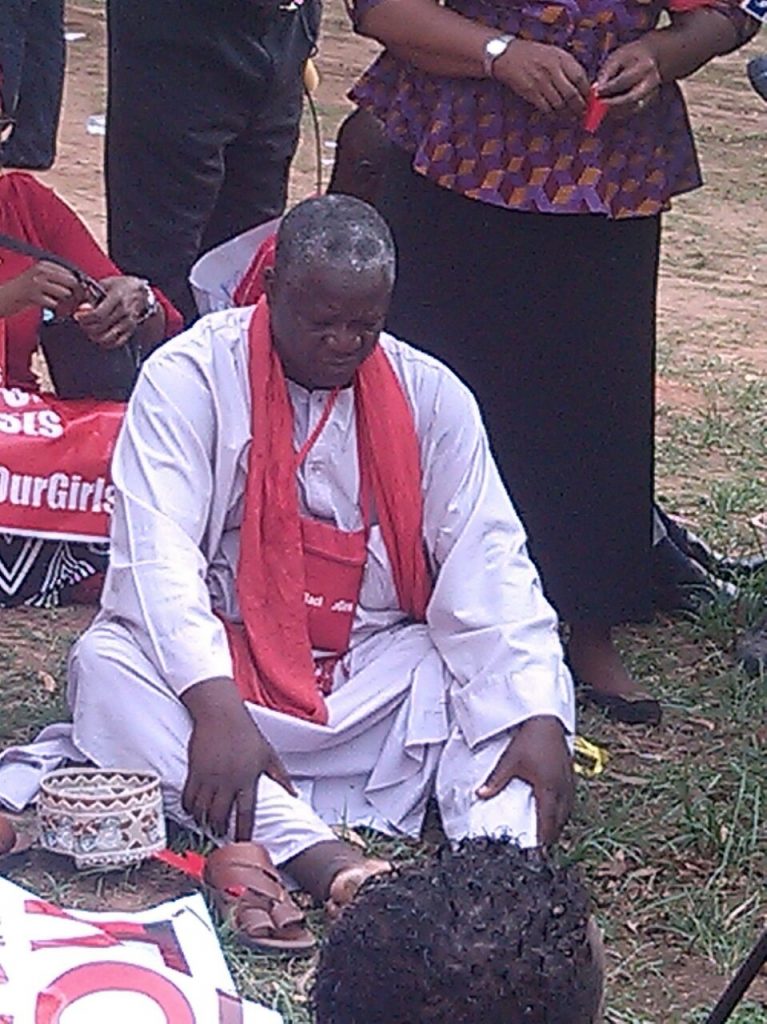
The #ChibokGirls with all the disadvantage they were born with decided that they would dare to take themselves out of the station that they were born into, and for daring to dream have been with abductors for a year. The world seems to have turned its back on the #ChibokGirls. The world seems to move on after the initial flurry of activity with the world saying #BringBackOur Girls. It was glamorous for people to hold the banner and say #BringBackOurGirls in the early days. People have moved on with their lives but for the #ChibokGirls and their families there is no moving on, not for a second for 365 days. Today it is exactly one year. My daughter has volunteered to be a #ChibokGirl Ambassador who would stand for the voiceless #ChibokGirls here in Abuja, and make demands that the government rescues the #ChibokGirls. This is what she had to say:
I see my parents every day and I feel guilty because 219 school girls haven’t seen their parents for one whole year. They live in fear of not knowing what is going to happen next whether they would live to see the next second, the next minute, the next hour, the next day. They have lost all hope especially in their country.
I feel sad that I live in a country, where 219 girls would be abducted and kept in captivity for 365 days and yet nothing is done, yet no attempt is made to rescue them, and everyone just moves on as if nothing ever happened. Why? They are kept in the hands of monsters that go around killing people and think they are practicing Islam, but Islam is a religion of peace not violence.
What if it were I that was abducted will everyone just move on and forget about me.
Bring Back Our Girls Now And Alive.
As long as the #ChibokGirls are left with abductors we have failed the children of the world especially the Girl-Child whom we tell is important and that she should dare to dream. Action, they say, speaks louder than words. The Girl-Child knows that it is all a lie because she can see the #ChibokGirls who dared and what happened to them.
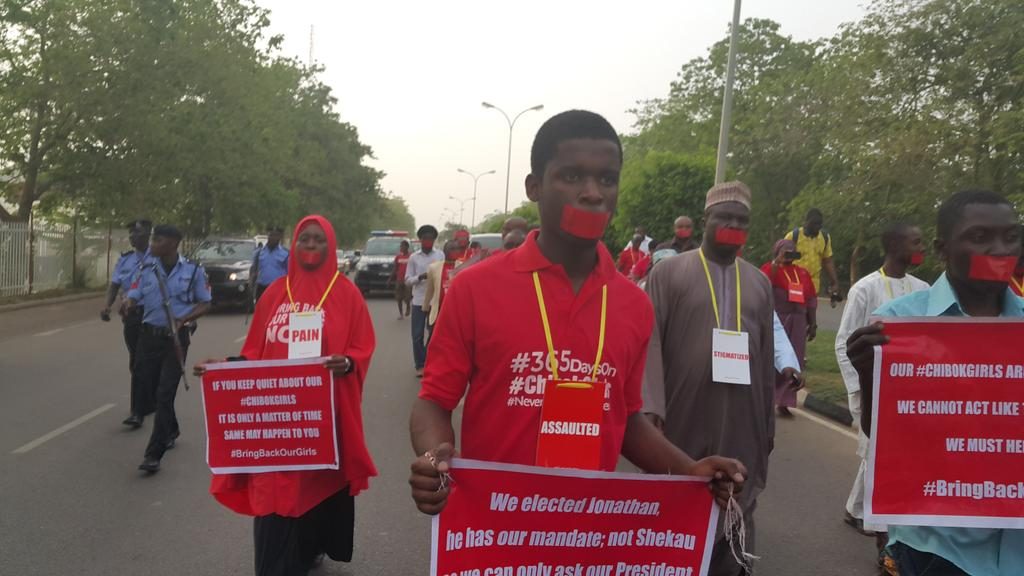
By failing to rescue the #ChibokGirls we have failed children all over the world. We have allowed terror be what they go to school expecting could happen to them, and this is not how it should be.
Due to what has happened to the #ChibokGirls and many others in that region a lot of parents are refusing to send their children to school where they are still open, and some are saying they would not send their children even when schools are opened. No parents should be made to choose between sending a child to school or their safety.
Work needs to be done to ensure that parents do send their children to school, lest the terrorist will have succeeded with their ideology of western education being forbidden. We must remember injustice to one is injustice to all. Terrorist attack to one is terrorist attack to all. Terror attack to anyone anywhere in the world is terrorist attack to everyone everywhere in the world.
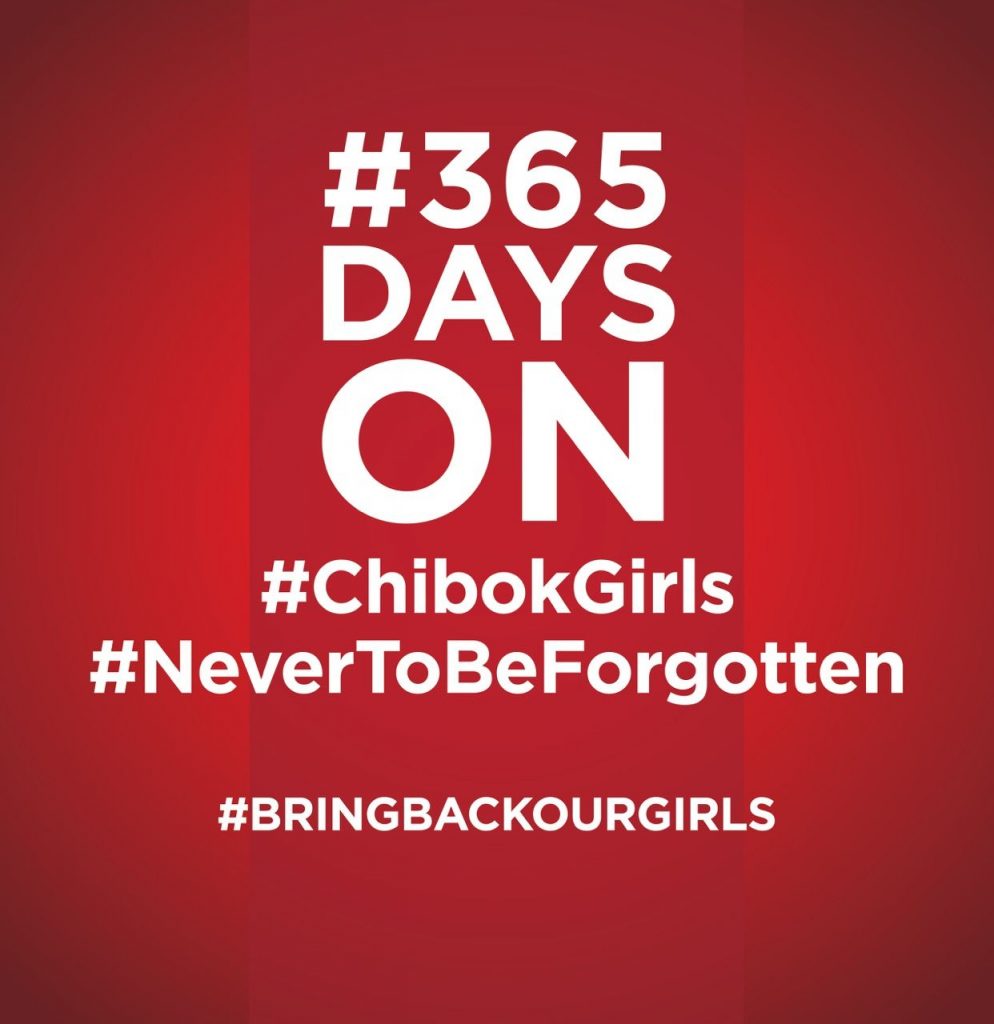
This is an original post written for World Moms Blog by Aisha Yesufu in Nigeria. All images provided by Aisha Yesufu.

 Every mother has the right to access the care they need during pregnancy and childbirth – care that can identify, prevent, and manage complications should they arise. But failure to meet these needs results in the loss of 800 mothers every day, even though up to 98% of these deaths are preventable.
Every mother has the right to access the care they need during pregnancy and childbirth – care that can identify, prevent, and manage complications should they arise. But failure to meet these needs results in the loss of 800 mothers every day, even though up to 98% of these deaths are preventable. 































